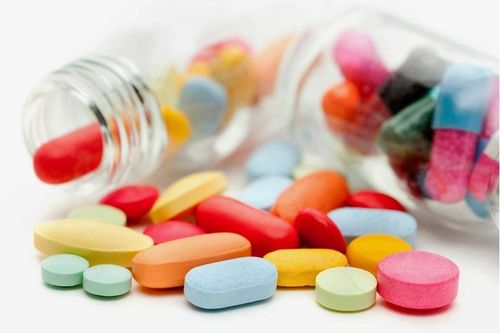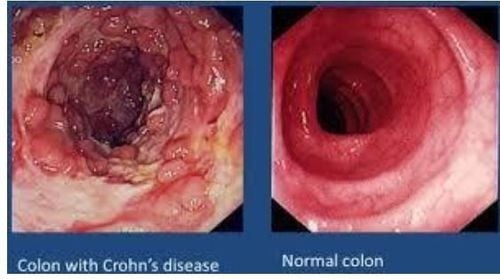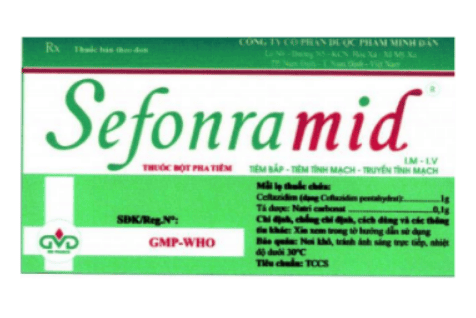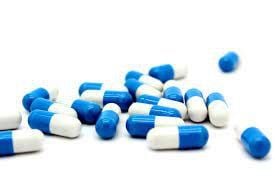This is an automatically translated article.
Vaciradin is a prescription drug used in the treatment of many different infectious diseases such as pharyngitis, tonsillitis, pyelonephritis, urethritis,... So what is Vaciradin and how to use it? How is this medicine?
1. What is Vaciradine?
What is Vaciradine? Vaciradin is an antibiotic drug prepared in the form of a powder for injection with the main ingredient in each vial is 2g of Cefradin in the form of a mixture of Cefradin and L-Arginin in the ratio 2:1.
Cefradine is a class I cephalosporin antibiotic. Cefradine has a medium spectrum of activity, it is active against gram-positive bacteria such as staphylococcus, streptococcus (except methicillin-resistant streptococci), pneumococci.
Cefradine is also active against some strains of gram-negative bacteria such as E.coli, Shigella, Klebsiella pneumoniae, Proteus mirabilis.
Antibacterial strains resistant to Cefradine include: Enterococcus, Enterobacter, methicillin-resistant Staphylococcus, Proteus with positive indole reaction, Pseudomonas aeruginosa, Bacteroides.
Vaciradin is indicated in the following cases:
Respiratory tract infections such as tonsillitis, pharyngitis, bronchitis, lobar pneumonia caused by susceptible gram-positive cocci. Urinary tract infections include: pyelonephritis, cystitis, urethritis and prostatitis. Skin and skin structure infections include: Abscess, inflammation, impetigo, boils,... Other infections such as otitis media, sepsis, bone infections. Infection prevention in surgery. Vaciradine is contraindicated in the following cases:
People with hypersensitivity to Cefradine. Pay attention to precautions when using Vaciradin in the following cases:
People with hypersensitivity to penicillin Patients with severe renal failure. People with a history of allergies: Asthma, rash, urticaria. Pregnant and lactating women should not take Vaciradine.
2. Dosage and how to use Vaciradin
The dose of Vaciradin should be strictly according to the doctor's instructions, the reference dose for specific cases is as follows:
Adults: Use a dose of 500mg - 1g, every 6 hours, deep intramuscular injection or injection slow intravenous infusion or intravenous infusion. Children from 1 year of age and older: Use a dose of 12.5 - 25mg/kg body weight, every 6 hours, intramuscularly or intravenously. Prophylaxis before, during and after surgery: For caesarean section: Use 1g dose, intravenously after clamping the umbilical cord. Then IM or IV dose 1g at 6 or 12 hours after the first dose. For other surgery cases: Use 1g dose intramuscularly or intravenously 0.5 - 1.5 hours before surgery. Then take 4-6 hours to inject once with a dose of 1g / time, within 24 hours after surgery. The total dose should not exceed 8g/day. Some notes on the dosage and usage of Vaciradin:
When using Vaciradin dose up to 300mg/kg body weight for seriously ill children, there are no obvious side effects. The maximum dose of Vaciradin for children should not exceed 8g/day. It is necessary to reduce the dose for patients with renal impairment, should use the initial dose of 750mg, then maintain at 500mg/time. The interval between dosing times is as follows: Creatinine clearance > 20ml/min: 6-12 hours once injected. Creatinine clearance from 15-19ml/min: 12-24 hours once injected. Creatinine clearance from 10-14ml/min: 24-40 hours injection once. Creatinine clearance from 5 - 9ml/min: 40 - 50 hours once injected. Creatinine clearance < 5ml/min: 50 - 70 hours once injected. Vaciradin should be stored in a cool place, protected from light, preferably between 15 - 30°C. Vaciradin solution after reconstitution will be effective within 2 hours at room temperature and effective for 24 hours when kept in the refrigerator at 5°C. Vaciradin-containing infusion solutions are effective for 10 hours when stored at room temperature and for 48 hours when stored at 5°C. If the drug is stored at cold temperature immediately after dissolving with distilled water for injection, the solution in the original bottle will be valid for 6 weeks at -20°C. Vaciradin solution after being dissolved may change color from pale straw yellow to yellow. However, this color change has no effect on the drug's effect.
3. Side effects of the drug Vaciradin
The most common side effects of Vaciradine include:
Hypersensitivity reactions Fever Serum sickness-like reactions. Anaphylaxis Skin rash Urticaria Eosinophilia Common side effects of Vaciradin include:
Nausea, vomiting. Diarrhea Pseudomembranous colitis Agranulocytosis. Bleeding complications Uncommon side effects of Vaciradin include:
Acute tubular necrosis may occur after using the drug in high doses and is often associated with people with a history of renal failure, elderly people. age or concomitant use with drugs that are also nephrotoxic, such as aminoglycoside antibiotics. Acute interstitial nephritis. Rare side effects of Vaciradin include:
Hepatitis Cholestatic jaundice Pain at injection site Thrombophlebitis after intravenous infusion with a total dose of more than 6g/day and interaxial for more than 3 days. If you experience any side effects of Vaciradin, you need to tell your doctor immediately or go to a medical facility for timely support.
Currently, the information about the drug interaction Vaciradin is not clear. However, to ensure effective treatment and avoid side effects and drug interactions, patients need to inform the treating doctor about the drugs, herbs, and supplements they are using. From there, the doctor will weigh the benefits and risks to appoint the patient to use the drug most effectively.
Follow Vinmec International General Hospital website to get more health, nutrition and beauty information to protect the health of yourself and your loved ones in your family.
Please dial HOTLINE for more information or register for an appointment HERE. Download MyVinmec app to make appointments faster and to manage your bookings easily.













